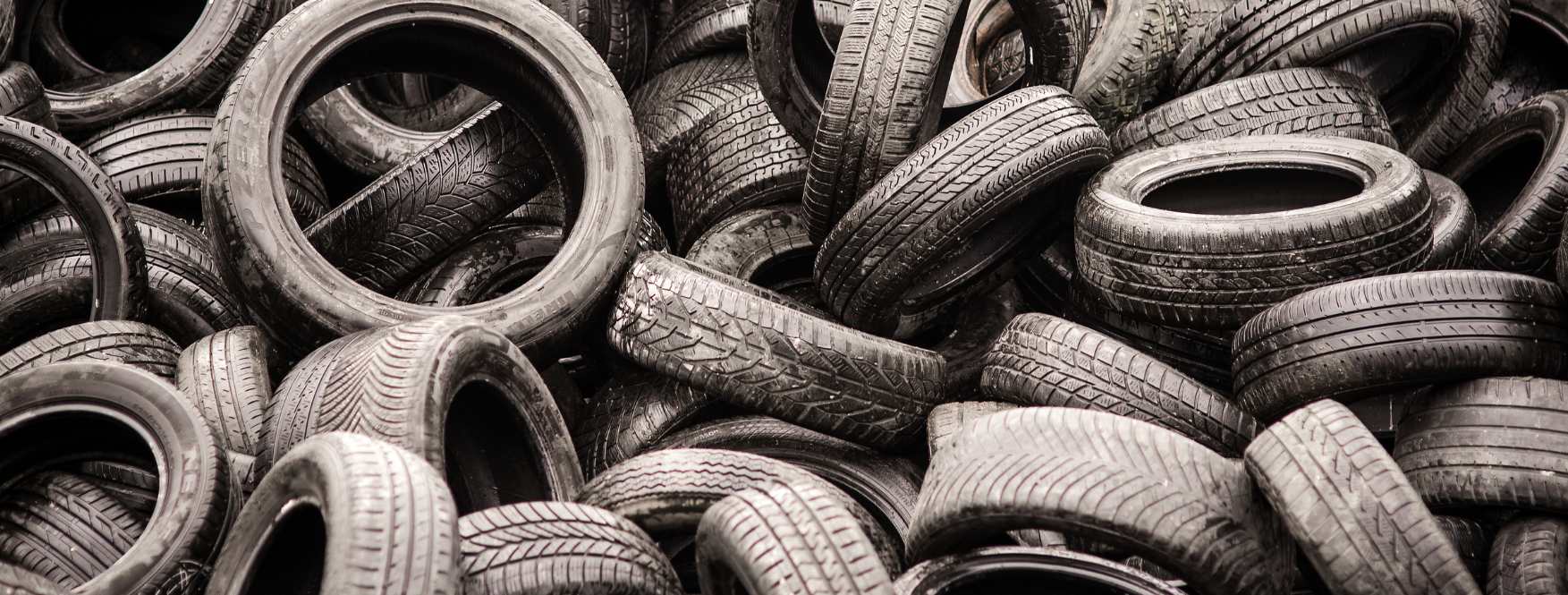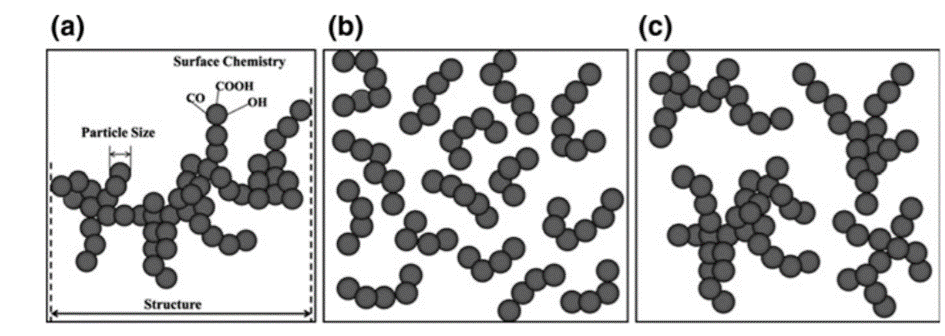
Carbon black tire grades and opportunities, explained
Carbon black is an essential component for many industries, particularly tire manufacturing. However, producing virgin Carbon Black requires burning fossil fuels, which is unsustainable and environmentally damaging.
Knowing the properties of different carbon black grades used in tire manufacturing can help in identifying circular, sustainable options to virgin Carbon Black.
What is carbon black?
Carbon black (CB) is a common resource in the manufacture of common consumer and commercial products such as tires, plastics, inks, insulating wires, etc.
Virgin carbon black (vCB) is a synthetic industrially produced powder made up of tiny spherical particles, 10 to 500 nanometers (nm) in size. vCB consists of over 98 per cent elemental carbon.

vCB particles have a high surface area and energy that makes them fuse to form aggregates, which define the vCB structure. Short chains produce vCB of low structure, while hundreds of particles forming large and branched aggregates produce high structure vCB, as you can see in Figure 1.
The two aggregate structures have varying properties that determine their applications. For example, high structure vCB has better dispersibility and is good for reinforcing compounds. Low structure vCB is more black in colour making it suitable for use in pigments.
As a sustainable option to vCB, recovered carbon black (rCB), a product of recycling end-of-life tires with similar composition and properties, is on the market.
Common carbon black grades
Carbon black production involves the partial or complete combustion of hydrocarbons under controlled conditions in specially designed furnaces. Sprays of coal tar, petroleum oils, or gas, the common feedstocks are heated at temperatures between 1,420 – 1,980°C to vaporise carbon that cools to form carbon particles.
Changing the fuel and the combustion conditions produces vCB of different grades. Internal nanostructure, particle size, aggregate structure, surface area per unit mass, abrasion resistance, tint strength, and amounts of ash and other compounds differentiate the grades.
The oil furnace process can produce most grades and accounts for 95 percent of global vCB production. The thermal black process accounts for less than 5 percent of vCB, while the lamp black process and the acetylene black process produce less than 2 percent of vCB.Over 90 per cent of virgin carbon black finds its way into rubber products – mainly for tire-related products like tubes, treads, belts, and hoses. Common carbon black tire grades are N120, N234, N326, N330, N339, N351, N550, N650, N660, and LH30. Other industrial rubber applications for Carbon Black are molded and extruded products.
The other 10 per cent of vCB is used for UV absorption, as a conducting agent in plastics, inks, and coatings, or as a pigment.
What are the different grades of carbon black?
There are over forty vCB grades in the world. The American Society for Testing and Materials (ASTM D1765), has classified these grades based on their manufacturing process, particle size, surface area, aggregate structure, abrasion resistance, and extrusion. These grades also determine applications of vCB as you can see in Table 1.
| vCB Grade(ASTM designation) | Particlesize (nm) | Surfacearea (m2/g) | Applications |
| N110 | 15-18 | 124-130 | High reinforcement. Used in tire products with high abrasion resistance. |
| N134 | 20-25 | 145 | High reinforcement. Premium tread for passenger, bus, and truck tires. |
| N220 | 20-25 | 112-115 | High reinforcement, tear strength, abrasion resistance. Tread for trucks and passenger tires. |
| N234 | 24-33 | 125 | High reinforcement. Has many applications, like tread for trucks. |
| N330 | 28-36 | 76-80 | Medium-high reinforcement, good flex and wear properties. Tread, carcass, and sidewall compounds for bicycle, passenger, and truck tires and rubber goods. |
| N339 | 28-36 | 95 | Medium-high reinforcement. Passenger tire treads, body compounds for tires, conveyor belts, and motor mounts. |
| N550 | 39-55 | 39-41 | Medium-high reinforcement and smooth extrusion. Used in inner liners, carcass, and sidewalls for passenger tires, rubber goods, hose, and extruded products. |
| N660 | 56-70 | 34-36 | Medium reinforcement, good flex, and fatigue resistance. Used in inner liners, sidewalls, sealing rings, cable jackets for tires, and rubber molding and extruded goods. |
| N770 | 71-96 | 31-32 | Semi-reinforcing. Inner liners for tires and rubber goods. |
| N880 | 180-200 | 17-20 | Low reinforcement. Used for non-tire rubber and plastic products. |
| N990 | 250-350 | 7-9 | Low reinforcement, hardness, and tensile strength; high loading capacity and elongation. Used for tire inner liners and rubber and plastic products, like wire insulation, footwear, belts, hose, etc. |
Just as the manufacturing process and feedstock yield different grades of vCB, there are also numerous variables in recovered carbon black. rCBs can have different particle sizes, aggregate morphology, ash content, and surface area and activity. rCBs can also be a mixture of various vCBs, volatile hydrocarbons, and ash content, making them difficult to classify. Presently, all rCBs fall into a single class, despite their different properties.
Therefore, in 2019, the Recovered Carbon Black Congress in Berlin, agreed to consider rCB as new material. And the ASTM workgroup 36 is currently formulating tests and quality descriptions for rCBs.
Carbon black in tires
In the early 1900s, a few years after Goodrich Tire Company began buying Carbon Black to improve the quality of their rubber, Sidney Charles Mote and a team of scientists discovered that Carbon Black had a reinforcing effect on rubber products.
The addition of Carbon Black greatly improved the abrasion resistance and strength of tires. Within a few years, the use of Carbon Black rubber mixtures became standard industry practice for tire manufacturers.
Besides reinforcement, tire manufacturers use Carbon Black because it can absorb UV light, which breaks down rubber. It also acts as an ozone scavenger and limits oxidation to prevent cracking. Coarser semi-reinforcing Carbon Black tire grades conduct the heat away from treads and belts and prevent thermal damage.
By making tires more durable and functional, carbon black tire grades make car and truck driving safer. Tire manufacturers use 73 per cent of vCB globally. Now, end-of-life tires (ELTs) can serve as an alternative feedstock to produce sustainable carbon black and close the loop.
Recovered carbon black: Sustainable focus
People discard around 1 billion tires each year globally, which has become a major waste management problem. One solution is material recovery from ELTs to provide alternative sources of carbon black, steel, oil, and gas to the tire industry.
Recovered carbon black from pyrolysis is a suitable and sustainable alternative to vCB. Major tire manufacturers have begun replacing vCB produced from fossil fuels with rCB.
It’s because of the technical, economic, and environmental advantages rCB offers:
- rCB can provide 100 per cent replacement for rubber and non-rubber applications of vCB.
- rCB has few polycyclic aromatic hydrocarbons (PAHs) compared to vCB.
- Local and regional collection and recycling can provide an assured source of rCB.
- Prices of rCB are stable as it doesn’t depend on fossil hydrocarbons.
- Prices for rCB are lower than vCB.
- Pioneer tire manufacturing businesses can enjoy a head start from rCB use.
- Reduction of carbon footprint by 80-90%. For example, Contec emits only 439kg CO2e/tonne of rCB, while carbon emissions are 2.5 tonnes CO2e/tonne of vCB production.
- Producers can transition to a circular economy to meet EU Green Deal requirements and UN SDGs.
The sustainability and performance of rCB will see it replace many virgin Carbon Black tire grades. At Contec, we enable tire manufacturers to do just this – by providing recovered Carbon Black, Oil, and recovered Steel from ELTs as sustainable options to current industrial production. Get in touch to learn more about our sustainable solutions.
If you liked reading this article, we recommend the following content: